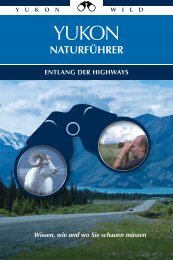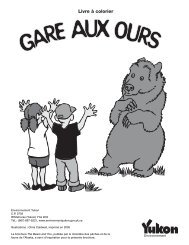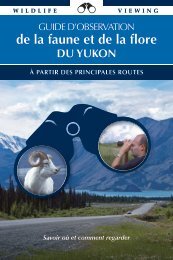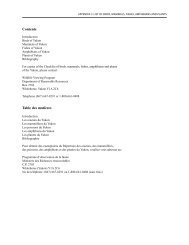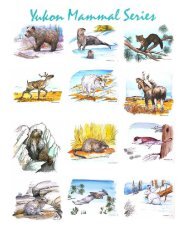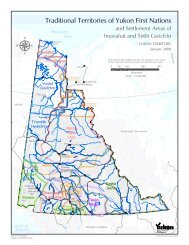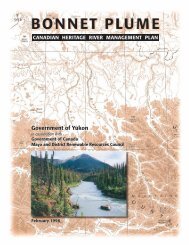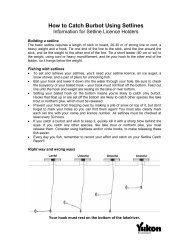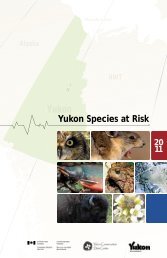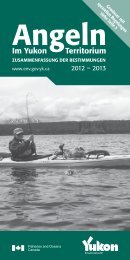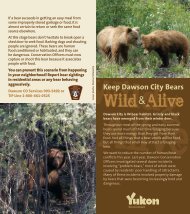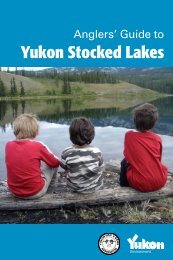Ch. 3 Land - Environment Yukon
Ch. 3 Land - Environment Yukon
Ch. 3 Land - Environment Yukon
You also want an ePaper? Increase the reach of your titles
YUMPU automatically turns print PDFs into web optimized ePapers that Google loves.
Waste oil is the largest component of<br />
special waste in the territory, and<br />
disposal of this product was not<br />
regulated before this time. For many<br />
years waste oil was spread on the roads<br />
in the territory to suppress dust, a<br />
practice that is no longer permitted.<br />
Waste oil collected by the City of<br />
Whitehorse was poured into one area<br />
of the landfill, where it is causing an ongoing<br />
environmental problem.<br />
A Pond of Oil<br />
For about 20 years, waste oil was<br />
dumped on top of piles of waste<br />
rock next to the War Eagle Pit.<br />
By the time this practice ended in<br />
1995, a shallow pond of oil had<br />
formed on the surface, and<br />
hydrocarbons now seep out of<br />
the toe of the waste rock pile.<br />
The city is now studying the site<br />
to determine the best way to treat<br />
and clean up this contaminated<br />
area.<br />
Shredding Rubber<br />
In Whitehorse, most waste oil is now<br />
burned in waste oil burners that are<br />
used to heat some businesses.<br />
Contaminated waste oil that is not<br />
acceptable for burning is shipped out of<br />
the territory.<br />
Now the Special Waste Regulations,<br />
together with the Dangerous Goods<br />
Transportation Act, and the Canadian<br />
<strong>Environment</strong>al Protection Act complete<br />
a cradle-to-grave management system<br />
for dangerous goods handled in the<br />
<strong>Yukon</strong>. The most common special<br />
wastes in the <strong>Yukon</strong> are used motor<br />
oil, solvents, paint, cleaners, anti-freeze,<br />
dry cleaning chemicals, photo-processing<br />
fluids, batteries and biomedical<br />
wastes.<br />
Under the regulations anyone who<br />
generates, stores, handles, mixes,<br />
disposes, collects or releases special<br />
wastes is considered a waste manager,<br />
and is responsible for knowing and<br />
complying with the regulations. Permits<br />
are required for generating, handling or<br />
disposing of special waste or for<br />
operating a special waste management<br />
Used tires are not an easy item to dispose of properly, and <strong>Yukon</strong>ers wear<br />
out between 11,000 and 15,000 tires every year. Most of the tires end up at<br />
the Whitehorse dump, and by 1999, it is estimated that the tire pile there<br />
contained about 300,000 tires.<br />
Tire piles are a major hazard. Fires have started in huge tire piles in several<br />
North American cities, and in 1997, a brush fire close to the Whitehorse<br />
landfill threatened to ignite the tire pile there before fire retardant was<br />
spread on the flames to stop the fire from spreading.<br />
The City of Whitehorse has made several attempts to dispose of the tires.<br />
In October 1999, the city shredded a substantial number of the tires, and<br />
will use the resulting material to cover parts of the city landfill. This pilot<br />
project could be expanded in the future. In November 1999, the city began<br />
charging a $4 fee for dropping off tires at the landfill, and those revenues<br />
will be used to truck tires to disposal centres in the south. The option of a<br />
tire stewardship program, in which a point-of-sale tax is added to the price<br />
of the tire, has also been discussed.<br />
facility (ie collecting waste from other<br />
sources). At the time of publication,<br />
139 special waste permits had been<br />
issued in the territory.<br />
The <strong>Yukon</strong> government ships special<br />
waste out of the territory once a year.<br />
Every year a tender is put out for<br />
operation of the Special Waste<br />
Collection Program. The successful<br />
contractor collects, transports, and<br />
looks after appropriate disposal for all<br />
the waste collected in this program.<br />
One other initiative in special waste<br />
management is the Household<br />
Hazardous Waste Collection days.<br />
Special waste accumulated in the home<br />
can be dropped off during advertised<br />
collection days in Whitehorse and some<br />
communities, diverting these products<br />
from garbage dumps.<br />
What are we doing about<br />
contaminated sites?<br />
Contamination is not an easy term to<br />
define. Some people might say that an<br />
area with piles of rusting drums, old<br />
equipment and crumbling buildings is a<br />
contaminated site. But according to<br />
territorial laws, only sites with chemical<br />
pollution are considered to be<br />
contaminated. The federal government<br />
manages contaminated sites on federal<br />
land, referring to them as waste<br />
management sites.<br />
The <strong>Yukon</strong> <strong>Environment</strong> Act<br />
Contaminated Sites Regulations<br />
The Contaminated Sites Regulations<br />
under the <strong>Yukon</strong>’s <strong>Environment</strong> Act<br />
were proclaimed on January 1, 1997.<br />
The regulations are intended to<br />
protect human health and the<br />
environment from harmful<br />
contaminants in soil and water. The<br />
regulations apply to sites on<br />
Commissioner’s <strong>Land</strong>, municipal land<br />
and private land. They do not apply to<br />
sites on federal land. The federal<br />
government has its own program for<br />
contaminated sites.<br />
5 8 ❧ Y U K O N S T A T E O F T H E E N V I R O N M E N T R E P O R T 1999





